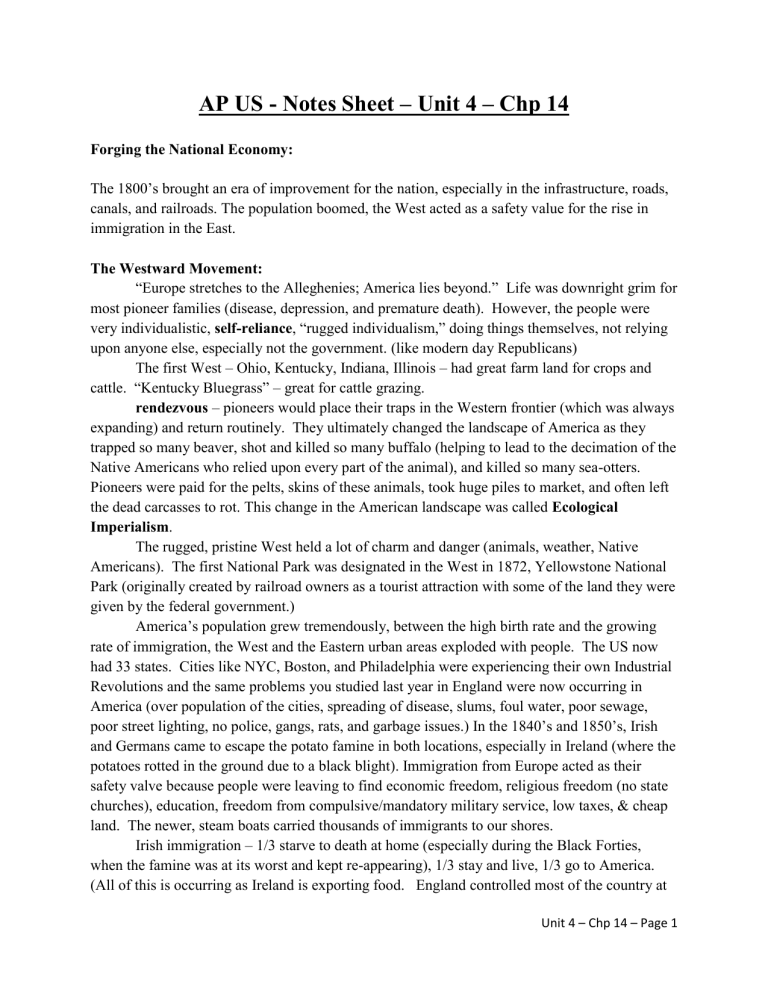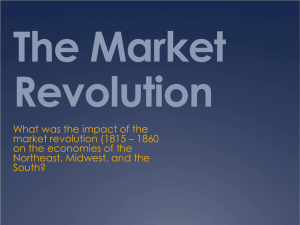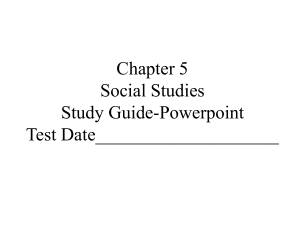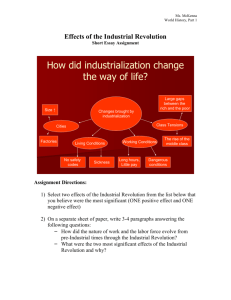Unit 4 - Chp 14 Notes

AP US - Notes Sheet – Unit 4 – Chp 14
Forging the National Economy:
The 1800’s brought an era of improvement for the nation, especially in the infrastructure, roads, canals, and railroads. The population boomed, the West acted as a safety value for the rise in immigration in the East.
The Westward Movement:
“Europe stretches to the Alleghenies; America lies beyond.” Life was downright grim for most pioneer families (disease, depression, and premature death). However, the people were very individualistic, self-reliance
, “rugged individualism,” doing things themselves, not relying upon anyone else, especially not the government. (like modern day Republicans)
The first West – Ohio, Kentucky, Indiana, Illinois – had great farm land for crops and cattle. “Kentucky Bluegrass” – great for cattle grazing. rendezvous – pioneers would place their traps in the Western frontier (which was always expanding) and return routinely. They ultimately changed the landscape of America as they trapped so many beaver, shot and killed so many buffalo (helping to lead to the decimation of the
Native Americans who relied upon every part of the animal), and killed so many sea-otters.
Pioneers were paid for the pelts, skins of these animals, took huge piles to market, and often left the dead carcasses to rot. This change in the American landscape was called Ecological
Imperialism .
The rugged, pristine West held a lot of charm and danger (animals, weather, Native
Americans). The first National Park was designated in the West in 1872, Yellowstone National
Park (originally created by railroad owners as a tourist attraction with some of the land they were given by the federal government.)
America’s population grew tremendously, between the high birth rate and the growing rate of immigration, the West and the Eastern urban areas exploded with people. The US now had 33 states. Cities like NYC, Boston, and Philadelphia were experiencing their own Industrial
Revolutions and the same problems you studied last year in England were now occurring in
America (over population of the cities, spreading of disease, slums, foul water, poor sewage, poor street lighting, no police, gangs, rats, and garbage issues.) In the 1840’s and 1850’s, Irish and Germans came to escape the potato famine in both locations, especially in Ireland (where the potatoes rotted in the ground due to a black blight). Immigration from Europe acted as their safety valve because people were leaving to find economic freedom, religious freedom (no state churches), education, freedom from compulsive/mandatory military service, low taxes, & cheap land. The newer, steam boats carried thousands of immigrants to our shores.
Irish immigration – 1/3 starve to death at home (especially during the Black Forties, when the famine was at its worst and kept re-appearing), 1/3 stay and live, 1/3 go to America.
(All of this is occurring as Ireland is exporting food. England controlled most of the country at
Unit 4 – Chp 14 – Page 1
the time, this is why many Irish-Catholics today still hate the English and they openly supported the IRA, a terrorist group meant to harm England.) When the Irish reach America, they are met by many “old” English that despise the new Irish for their culture, new religion, lack of education, and simply for being Irish, which is why “Irish Need Not Apply” appeared in many shops. This bigotry/racism was felt all over the North East and the Nativists – people that were often born in the US and did not like the foreigners because they were driving down wages and corrupting our society banded together in gangs (see the film Gangs of NY, “Bill the Butcher”), political parties (the “Know-Nothing” or American Party) and/or leaders of industry or communities..
Most Irish immigrants were Catholic, different from the original immigrants (mostly white, Anglo-Saxon – British - & Protestant or WASP for short). The “old” immigrants came mostly from northern and western Europe and were Protestant, a different religion from the Irish, which is one of many reasons why they were hated and treated as poorly in the North as freed blacks all across America (free but had very little real rights). The blacks and the Irish fought, often for the lowest paying jobs. The “famine Irish” were befriended by very few, but the
Ancient Order of Hibernians ( the group that puts on the St. Patrick’s Day Parade today) helped them and help form the
Molly Maguire’s
, a group of Irish coal miners that formed a coal strike in the late 1800’s.
Tammany Hall in NYC soon noticed the rising number of Irish immigrants and utilized their power in numbers at the voting booth to get their people elected.
Tammany Hall is eventually led by Boss Tweed . The Irish form gangs to stay alive and many also join the government ranks as police officers and later as firefighters. During the Civil War, some literally get off a boat from Ireland, sign up for the Union Army, and are shipped off to war on another boat.
German immigrants were largely farmers too (remember their potatoes rotted, too) but some were liberal political refugees. Most of the Germans were more educated and came from more means than the Irish; therefore, they moved West at a faster rate, usually settling in
Pennsylvania (the Pennsylvania Deutch – Germans) or in Wisconsin. The words Kindergarten and bier (beer) were both derived from German immigrants. Some of these immigrants were
Protestants and others were Catholics. The Anti-Catholic sentiment in the US was pervasive in the North Eastern cities and all across the US thanks to the nativists . Burning a Catholic Church was not uncommon (think about it, we have had only one non-Protestant president, JFK, and he had to give a speech explaining why he would not just listen to the Pope, the leader of the
Catholic Church in Rome and why it was OK to vote for a Catholic if you weren’t one. That was in 1960. Mitt Romney had to do the same thing, he gave a speech in regard to his Mormon faith in 2008. Being different has never been easy or easily accepted.)
One thing is for sure, the growing America, with its own Industrial Revolution starting to bloom, needed immigrants to fill jobs in the cities, to man farms in the West to feed the
Eastern urbanites, and to settle the new United States of America. The Industrial Revolution in
America really takes hold in the early 1800’s because England made it a state secret to develop factories. It was not until Samuel Slater created the first factory in America in 1791 by memory,
Unit 4 – Chp 14 – Page 2
that our revolution really began. Soon, others copied his ideas and the Revolution began.
However, it did not take hold until Eli Whitney first developed the Cotton Gin in 1793
(revolutionized the picking of cotton in the South, allowing one slave to pick a pound a cotton a day to hundreds of pounds in a day. This increased the need for larger plantations – Southern farms – and for slaves themselves). Coincidentally, Eli Whitney also helped the Northern factories by making moveable parts (originally for guns) so goods could be mass produced
(largely mistakenly credited to Henry Ford and the assembly line, which was also used in a
Whitney factory). Thiis fresh cotton grown in the South helped fuel the textile (clothing) factories in the North. The two parts of the country (the South & the North) needed each other, it was a symbiotic relationship, that they did not realize, amongst the issues of state’s rights and slavery. New England sprang up with many new factories because of their natural harbors (to bring in immigrants and raw materials and to ship out finished goods), big populations to work in the factories, and most importantly the fast moving rivers to power the factories. The War of
1812 helped bolster these factories and their development, along with the calls for
“nonimportation” and the early tariffs, like the Tariff of 1816. The Tariff of Abominations only came about after British factories dumped their overabundance of goods in the US marketplace for very cheap. Other inventors – Samuel Colt: the Colt Revolver, Isaac Singer: the sewing machine, Samuel Morse: Morse code. (It was the Morse Code and the telegraph service that limited the work of the Pony Express, those who delivered the mail, to only one year of service.
The development of railroads also helped.) Charles Goodyear invented vulcanized rubber, eventually used in tires, and the McCormick reaper, which helped cut high grass at a very quick rate.
The Industrial Revolution was kind to the owners, bosses (management & the new middle class), but not to the underpaid, who were often hurt or maimed workers. Every immigrant was cheaply hired and easily replaced so there was no need to worry about safety guards on machines, poor lighting, poor ventilation leading to tuberculosis in the factories and
“black lung” in the mines. Children worked for the least, women less than men, and adult males the most. Most families had all the kids and parents working to make ends meet in the cities
(especially in the slums or tenement houses). The one thing that the workers did have was the right to vote, an advantage gained in the Jacksonian Democracy that lessened land rights in order to vote, leading to more rule by the average, common man, or as others might say, “mobocracy”. Many workers wanted simple things like a 10 hour work day, free public education for their kids (although Catholics often gave whatever they could to fund Catholic schools and a
Catholic education), and better working conditions. The problem is that early unions were opposed by the government and industry. Strikes were often broken by the military and scabs or rats were hired to replace missing workers. However, unions did get a boost when
Commonwealth v Hunt ruled that unions were allowed to be formed. Factory girls , usually young females worked six days a week in the factories to make money for their families.
Catherine Beecher, sister of Harriet Beecher Stowe – who wrote Uncle Tom’s Cabin, the abolitionist book, tried, quite successfully to move many females into teaching, but no matter
Unit 4 – Chp 14 – Page 3
what once they were married, they were almost forced to give up working in the mills, as servants, nursing, and teaching. The Cult of Domesticity became a mandatory sentence (mindnumbing and underappreciated) for most married females. Although American women created new ways to raise their children as individuals, their hard work was often ignored.
The Eastern factories that revolutionized working in the factories did the same for the
Western farmers with McCromick’s reaper and the steel plow (made by John Deere). It made work easier and turned unusable land in to productive acres. (especially in the thick sod/grass on the Great Plains). The Eastern factories also led a need for new markets and a place to get raw materials in the West. Many of the canals, turnpikes, and the railroads were built coming out of the Northeast for these reasons as well as to move pioneers West. One of the most famous turnpikes began in Lancaster Pennsylvania. It turned a healthy profit for its shareholders because it was a stable road that became widely used. The National Government got involved in the process, building the Cumberland Road, which began in Maryland. Steamboat’s, using
Robert Fulton’s steam engine (his boats were also used on the Mississsippi), helped trans-
Atlantic voyages become shorter ones and another invention, not transportation related, was made by Cyrus Fields, who created the Trans-Atlantic Cable.
Other important inventions included the “Clipper boats” (faster moving sail boats) and the Pony Express (a romantic way to move mail on horseback) were quickly replaced and short lived as they were replaced by the Steam boat and Morse Code quickly after their inventions.
The East and the West became conjoined by the Transportation Revolution. The Market
Revolution led a small system of subsistence farms to unite and grow cash crops in the West while to the East where the small “Home Made” goods were now produced by big machines in factories.
One major problem of the Industrial Revolution (besides the ones already mentioned) was the growing gap between rich and poor, especially in the North Eastern cities, where people like John Jacob Astor died with millions (granted he gave a lot away, like to build the Bronx
Zoo and other big things in NYC) while others were forced to live in slums.
Unit 4 – Chp 14 – Page 4






